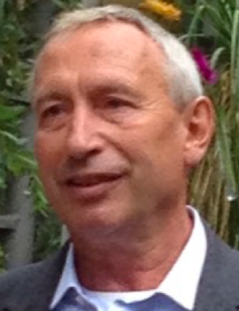Co-Located Conference AgendasCirculating Biomarkers, Exosomes & Liquid Biopsy Europe 2019 | Exosomes-EV-based Therapeutics Summit | 

Wednesday, 30 October 201908:00 | Conference Registration, Materials Pick-Up, Morning Coffee and Pastries in the Exhibit Hall | |
Session Title: Conference Opening Session -- Emerging Themes in Circulating Biomarkers, circa 2019 |
| | 09:00 |  | Conference Chair Conference Chairman's Welcome and Introduction to the Conference
Dominique PV de Kleijn, Professor Experimental Vascular Surgery, Professor Netherlands Heart Institute, University Medical Center Utrecht, The Netherlands, Netherlands
|
| 09:15 |  | Keynote Presentation Circulating Tumor Cells to Guide Treatment of Cancer Patients
Leon Terstappen, Chair Medical CellBiophysics, MIRA Research Institute for Biomedical Technology and Technical Medicine, University of Twente, Netherlands
The presence of Circulating Tumor Cells (CTCs) enumerated with the
CellSearch system is associated with relatively poor survival and their
reduction after the first weeks of therapy indicates a response to
therapy. Present research focus is on the ability to extract treatment
relevant information from the proteins, RNA and DNA in these CTC. |
| 09:45 |  | Keynote Presentation Clinical Applications of Circulating Tumor Cells to Predictive Oncology
Patrizia Paterlini-Brechot, Professor of Oncology/Molecular Biology, University Paris Descartes, France
Circulating Tumor Cells (CTC) and Circulating Tumor Microemboli (CTM) are Circulating Rare Cells which herald tumor invasion and are expected to provide an opportunity to improve the management of cancer patients and help to detect the most aggressive invasive cancers before other diagnostic approaches like imaging. We report on the clinical applications of CTC in predictive oncology and more specifically on the ISET® (Isolation by SizE of Tumor/Trophoblastic Cells) open system for marker-independent isolation of tumor cells from blood which allows to reliably diagnose and count CTC.
Independent published data from several international research teams have demonstrated the prognostic relevance of CTC detection by ISET® in patients with melanomas, as well as lung, colorectal, liver, pancreatic, head and neck, and ovarian cancers. Furthermore, the utility of theranostic characterization of CTC by ISET® has been demonstrated for non-small-cell lung cancers, colorectal cancers and melanomas. |
| 10:15 | Tracking Circulating DNA for Cancer Patient Follow-Up
Valérie Taly, CNRS Research Director, Professor and Group leader Translational Research and Microfluidics, Université Paris Cité, France
Tracking of circulating cell-free nucleic acids in body effluents has been greatly facilitated by recent technological developments including droplet-based digital PCR and optimized NGS. These technics now allow to reach unprecedented sensitivity and precision for rare sequences detection and quantification. Strategies allowing analysis of several genetic and epigenetic cancer-specific alterations have will be presented for the detection of tumor DNA in patient samples. Moreover to demonstrate the pertinence of such procedures to overcome clinical oncology challenges, the results of several clinical studies will be presented. In particular, we will illustrate the pertinence of these approaches to monitor circulating tumor DNA in plasma (so-called liquid biopsy) for the follow-up of patients with localized or advanced cancers. | 10:45 | Morning Coffee and Tea Break and Networking in the Exhibit Hall | 11:30 |  | Keynote Presentation The Theranostic Potential of Membrane Hsp70 in Cancer: Development of a Liquid Biopsy and an Approach for Isolating Circulating Tumour Cells (CTCs)
Graham Pockley, Director and Professor, John van Geest Cancer Research Centre, Nottingham Trent University, CEO, multimmune GmbH, United Kingdom
A cell surface bound form of the 70 kDa heat shock (stress) protein Hsp70 is selectively and widely expressed on the plasma membranes of many tumour entities. This presentation will describe the development of a liquid biopsy for identifying patients bearing membrane Hsp70-expressing tumours, the current status of an NK cell-based therapeutic for the treatment of such tumours, and, separately, the development of an approach for isolating circulating tumour cells (CTCs) based on their expression of membrane Hsp70. |
| 12:00 | Networking Lunch in the Exhibit Hall, Exhibits and Poster Viewing | |
Session Title: Circulating Cell-Free DNA (cfDNA) and Circulating Tumour Cells (CTCs) -- Circulating Biomarkers for Liquid Biopsy |
| | 13:30 | CTC Isolation for Single Cell Analysis
Clotilde Costa, Translational Medical Oncology Group, Joint Unit Roche-Chus, Oncomet, Universitary Cinical Hospital of Santiago de Compostela, Spain
CTCs analysis at single-cell level allows the study of tumor heterogeneity in a minimally invasive way. CTCs repeated sampling offers real time information of the tumor and potentially is a tool for therapeutic strategy decisions. Present research shows single cell isolation using three different technologies (VyCAP puncher, DEPArray and manual micromanipulation) and subsequent sequencing analysis (Oncomine comprenhensive assay). Metastatic breast and prostate cancer patients before and after treatment (chemotherapy) were considered for this study. | 14:00 | Leveraging the Genome-Wide Cell-Free DNA Fragmentation in Patients With Cancer
Florent Mouliere, Assistant Professor, Cancer Center Amsterdam, VUMC Amsterdam, Netherlands
Liquid biopsies, and circulating tumor DNA (ctDNA) in particular, are used to non-invasively detect the presence of cancer cells. ctDNA is commonly detected though the presence of genetic alterations in its sequence. Since the majority of ctDNA in circulation is non-mutated, leveraging this untapped resource of tumor information makes sense for improving cancer detection, notably in early stage and brain cancers. Here I will show how the genome-wide fragmentation of cell-free DNA could be leveraged to enhance the detection of ctDNA. | 14:30 | Considerations and Quality Controls When Analyzing Cell-Free Tumor DNA
Anders Ståhlberg, Associate Professor, Sahlgrenska Cancer Center, University of Gothenburg, Sweden
Analysis of circulating cell-free tumor DNA (ctDNA) in liquid biopsies offers new means for early cancer diagnostics, real-time monitoring of treatment efficiency and detection of relapse. Despite its potential use ctDNA remains challenging to detect and to quantify as it represents only a small fraction of all cell-free DNA. We have developed an ultrasensitive sequencing technology, SiMSen-Seq, that allows allele frequencies < 0.1% to be detected. SiMSen-Seq is simple to perform, flexible in multiplexing and requires minimal DNA input. Here, we discuss important considerations for ctDNA detection in plasma, including all experimental steps from sampling to data interpretation. We will also discuss how the use of high fidelity enzymes reduce error rates in barcoded NGS. The use of quality control assays enables the development of robust and standardized workflows that facilitate the implementation of ctDNA analysis into clinical routine. | 15:00 |  | Keynote Presentation Isolation and Multiplex Analysis of Tumor Cells and Tumor DNA From Body Fluids on a Chip
Lorena Diéguez, Leader of the Medical Devices Research Group, INL- International Iberian Nanotechnology Laboratory, Portugal
Early dissemination of cancer is difficult to detect by traditional imaging and pathological methods. While the presence of cancer material in body fluids is well known, current techniques for the isolation, analysis and characterization of these biomarkers are not efficient enough to be fully applied in clinical routine.
In recent years, microfluidics has been widely reported for efficient isolation of CTCs and free nucleic acids. Moreover, microfluidics and microdroplets offer miniaturization, automation, high-throughput, and intrinsic reproducibility. Despite fluorescence has been the main detection technique integrated within microfluidics and microdroplets, SERS allows higher detection limits and offers much more information than fluorescence, as the Raman spectrum is the fingerprint of the analyte under study and allows multiplex detection.
In this talk, we present our work for isolation and multiplex analysis of cancer biomarkers from body fluids based on microfluidics, microdroplets and SERS. The present approach combines the device engineering for size isolation, with nanotechnology engineering and optical detection. The development of this platform encounters a remarkable advance towards personalized medicine, especially in the field of cancer research.
|
| 15:30 | Afternoon Coffee and Snack Break and Networking in the Exhibit Hall | 16:15 | CTC Genetic Diversity Through Single-Cell Analysis and CDX Development
Patrycja PAWLIKOWSKA, Researcher, Gustave Roussy, France
Tyrosine kinase inhibitors (TKIs) tailored for oncogenic driver alterations have shown unprecedented success in patients harboring EGFR-mutations, ALK- or ROS1-gene rearrangements. However the long-term effectiveness of TKIs is invariably limited by the development of resistance. CTCs are a powerful means to identify genetic alterations predictive of sensitivity or resistance to TKIs, inform on tumor heterogeneity and resistance mechanism, and the characteristics of cancer cells with metastatic potential. Using filter-adapted FISH, we reported ALK-rearrangement detection in CTCs from ALK-rearranged patients and how CTCs with abnormal ALK FISH-patterns monitored on treatment can stratify patients at risk of early-resistance to first-line ALK inhibitor crizotinib. Recently, we developed several workflows enabling to identify resistance mutations to ALK-inhibitors. Individual CTCs were isolated by laser-microdissection of filters, fluorescence-activated cell sorting or the DEPArray, and tested for more than 2000 hotspots in cancer oncogenes and ALK-mutations. Shared mutations between CTCs and tumor biopsies at resistance to crizotinib and lorlatinib (third generation ALK inhibitor) and CTC-private (exclusively present in CTCs) mutations were thoroughly explored (Pailler et al, in revision).
CTC-derived explant (CDX) model are useful tools to explore drug resistance and improve knowledge on the genetic and phenotypical profile of CTCs that seed metastasis. Our team has recently conducted a project to develop and functionally characterize CDXs in two tumors types i.e. NSCLC and prostate cancer (PCa). In PCa, we established and completed the genetic characterization of a CDX model which was found to recapitulate a mechanism of neuroendocrine transdifferentiation and resistance to therapies targeting the androgen receptor pathway (Faugeroux et al., in revision). These results will be presented at the conference. | 16:45 | High Blood Volume Approaches to Improve CTC-based Liquid Biopsies
Nikolas Stoecklein, Professor, University of Dusseldorf, Germany
The direct access to systemically spread cancer cells is the true potential of CTC-based liquid biopsies. However, the major obstacle to implement CTC-based liquid biopsies into clinical routine applications is the extreme low concentration of CTCs and the minimal amount of investigated blood in standard CTC-tests. To tackle this problem, we introduced Diagnostic Leukapheresis (DLA), which increased significantly CTC detection frequency and resulted in an escalation of CTC numbers. We hope that DLA, or similar approaches derived thereof, will advance the clinical utility of CTC-based liquid biopsies. Besides DLA, I will review some new alternative approaches also aiming to increase the investigated blood volume in my talk. | 17:15 | Exploiting RNA In Liquid Biopsies For Precision Medicine Purposes
Jo Vandesompele, Professor, Ghent University and CSO, Biogazelle, Belgium
In contrast to general belief, a substantial part of the human transcriptome is abundantly present in the blood and other biofluids as extracellular messenger RNA, long non-coding RNAs and various small RNAs, ready to exploited. I will discuss various workflows for RNA sequencing of biofluid derived RNA, including probe-based target capture and unbiased total RNA library prep as sensitive RNA sequencing workflow to study thousands of mRNA and lncRNA genes in cell-free RNA from patients’ plasma and other biofluids. Apart from RNA abundance profiling, this type of data can also be used to detect structural RNA variants, such as somatic mutations, fusion genes and RNA editing events, all known to play an important role in disease, including cancer. The resulting RNA profiles can be deconvoluted to enumerate the cells, tissues and organs that contribute to the extracellular RNA. Human biofluid RNA sequencing enables liquid biopsy guided precision oncology, such as therapy stratification, treatment response monitoring and early detection of relapse. I will also discuss the pre-analytical jungle of RNA targeted liquid biopsies and need for standardization, as part of the ongoing extracellular RNA quality control study. I will end with the first insights of the Human Biofluid RNA Atlas, in which we have deeply probed into the extracellular transcriptome of 22 human biofluids, providing a solid foundation for exploiting biofluids for diagnostic purposes. | 17:45 |  Immunophenotyping Extracellular Vesicles Using Amnis Imaging Technology Immunophenotyping Extracellular Vesicles Using Amnis Imaging Technology
Owen Hughes, Amnis Sales Specialist UK, Luminex
Only recently has the importance of extracellular vesicles (EVs) as key mediators of intercellular communication been appreciated. EVs are membrane-derived structures that include exosomes, microvesicles, and apoptotic bodies. Exosomes have been shown to transfer molecules between cells, and have the potential to transfer signals between cells. Exosomes are released under normal physiological conditions, however, they are also assumed to serve as mediators in the pathogenesis of neurological, vascular, hematological, and autoimmune diseases, as well as cancer. Moreover, EVs have the potential to function as novel biomarkers and are promising delivery systems for therapeutic bioactive molecules.
Quantifying and characterizing EVs in a reproducible and reliable manner has been difficult, due to their small size (exosome range from 30–100 nm in diameter). EV analysis can be done using high-magnification microscopy, however, this technique has a very low-throughput. Attempts to analyze extracellular vesicles using traditional PMT-based flow cytometers has been hampered by the limit of detection of such small particles and low refractive index. To overcome these limitations we have employed the Amnis imaging technology, which has the advantage of high-throughput flow cytometry with higher sensitivity to small particles, due to the timedelay-integration image capturing system. In this study, the Amnis imaging technology is used to immunophenotype EVs. Strategies to optimize detection of EVs will also be discussed.
| 18:15 | Close of Day 1 of the Conference |
Thursday, 31 October 201908:00 | Morning Coffee, Pastries and Networking in the Exhibit Hall | |
Session Title: Emerging Themes and Trends in Extracellular Vesicles (EVs)/Exosomes Field |
| | 08:30 | Saliva, Exosomes and Type 2 Diabetes Diagnostics
Christa Noehammer, Senior Scientist, Austrian Institute of Technology, Austria
Saliva is a readily and even within short time intervals repeatedly available body fluid, which can be obtained via non-invasive, painless collection. In addition, saliva represents a basically unlimited sample matrix and further offers the advantage of not requiring any special skills for collection. Saliva contains a broad range of relevant molecule classes, such as DNA, messenger RNA, micro RNA, lipids, proteins and antibodies, which all can be used as potential disease/health biomarkers. Along these lines Saliva diagnostics is an emerging field of molecular diagnostics, not least because scientific findings increasingly show that measuring and quantifying salivary biomolecules can be used not only to detect local diseases of mouth and throat but also to diagnose systemic diseases. Due to these opportunities and advantages a recent special interest of the Molecular Diagnostics research group at the AIT Austrian Institute of Technology is to evaluate saliva for its suitability for circulating biomarker-based diagnostics. Along these lines we will show proof of concept studies for autoantibody- and DNA-methylation based salivary diagnostics and report on the evaluation of different commercially available strategies for isolation of exosomes from human serum and saliva. We will further present data from comparative profiling studies in salivary - and serum-derived exosomes including targeted protein-, genome-wide microRNA – as well as DNA-methylation profiling. Last but not least we will report on results of a research project where we are looking for salivary and plasma exosome-derived epigenetic biomarkers for early type 2 diabetes diagnosis. | 09:00 |  | Keynote Presentation Distribution of Non-Coding RNAs Over EV and Other RNA Carriers in Plasma
Esther Nolte-‘t Hoen, Assistant Professor, Department of Biochemistry & Cell Biology, Faculty of Veterinary Medicine, Utrecht University, Netherlands
|
| 09:30 |  | Keynote Presentation Plasma Extracellular Vesicles as a Biomarker Source for Cardiovascular Disease
Dominique PV de Kleijn, Professor Experimental Vascular Surgery, Professor Netherlands Heart Institute, University Medical Center Utrecht, The Netherlands, Netherlands
Cardiovascular Disease (CVD) is with cardiovascular events of Ischemic Heart Disease (IHD) and Stroke, the number 1 and 2 cause of death in the world and expect to increase especially in Asia.
We use protein signatures measured in 3 different subsets of plasma extracellular vesicle (EV) as an accurate source for early diagnosis and prediction of cardiovascular events like IHD and Stroke.
The diagnosis IHD is challenging, as many patients present with atypical symptoms. It is known that women have a different symptom sensation than men. Troponins are the main diagnostic tool for detection of MI. Blood biomarkers for stable angina (SA) and unstable angina (UA), however, are not available. These diagnoses frequently require hospital visits/admissions for time-consuming and costly (non)invasive tests. Using a simplified method that is suitable for automation and microfluidics to isolate the plasma EV subfractions in 25 ul plasma, we now validated our data in a large case control study (150 cases vs 300 controls) that showed that EV subfractions can diagnose accurately SA in a drop of blood. Next to this, using another signature in plasma EV subfractions for patient that undergo a carotid endatherectomy (CEA) we could accurately determine which patient will get a second cardiovascular event (myocardial infarction, stroke or death) or not within 3 years after CEA.
Plasma EV subfractions are a very valuable biomarker source for the diagnosis and prognosis of cardiovascular disease. |
| 10:00 | Standardized Analysis of Extracellular Vesicles in Liquid Biopsies
An Hendrix, Professor, Ghent University, Belgium
The identification of extracellular vesicle (EV)-associated biomarkers is challenging owing to the complexity of liquid biopsies. We 1) performed quality control studies to identify the impact of (pre-) analytical variables on biomarker identification, 2) developed reference materials to ensure standardized EV measurements, and 3) created EV-TRACK to stimulate researchers to put experimental guidelines into practice. This combined expertise boosted the identification of bacterial EV in the systemic circulation of patients with intestinal barrier dysfunction. | 10:30 | Morning Coffee Break and Networking in the Exhibit Hall | 11:00 | Exosomal-miRNA Signatures in Circulation
Michiel Pegtel, Associate Professor, Cancer Center Amsterdam, VU University Medical Center, Netherlands
The peripheral blood is rich in cell-free microRNAs (miRNA) that are derived from both living and dying cells. A proportion of these miRNAs are protected from RNAses within vesicles including apoptotic bodies, microvesicles and exosomes. In vitro, exosomes can transport miRNAs to recipient cells, which may also occur in vivo although the physiological relevance and molecular mechanisms of cell-cell transfer of miRNAs has not been established. In this presentation I will discuss our clinical studies concerning exosomal miRNAs as cancer biomarkers for therapy response evaluation and the potential of exosomes as therapeutic delivery vehicles. | 11:30 | Liquid Biopsy -- Exosomal microRNA Biomarker Signatures in Clinical Diagnostics
Michael Pfaffl, Professor, Technical University of Munich, Germany
Extracellular vesicles (EVs) are circulating in body liquids and are involve in the intercellular communication with key functions in physiological and pathological processes. In recent time especially the exosomes have gained huge interest because of their molecular diagnostic potential, mainly based on the containing microRNAs.
The past decade has brought about the development and commercialization of a multitude of extraction methods to isolate EVs and exosomes, primarily from blood compartments. The exosome purity and which subpopulations of EVs are captured strongly depend on the applied isolation method, which in turn determines how suitable resulting samples are for potential downstream applications and biomarker discovery. Herein we compared the performance of various optimized isolation principles for serum EVs/exosomes in healthy individuals and critically ill patients, suffering pneumonia and/or various stages of sepsis. The isolation methods were benchmarked regarding their suitability for biomarker discovery as well as biological characteristics of captured vesicles. Isolated vesicles were phenotypic and molecular characterized by Nano Tracking Analysis, (NTA) (EV concentration, EV mean size, EV size distribution), surface marker proteins (positive and negative markers via western blotting), and containing small-RNA families (small-RNA and isomiRs via small-RNA NGS). To analyze the deep sequencing results, a self-established bioinformatics pipeline for microRNA (based on R) and a deeper analysis of their isoforms (via isomiRROR) was applied.
First goal was the development of microRNA/isomiR biomarker signature in a learning cohort with over 116 patients for an early diagnosis and for a valid classification of critical ill patients. Various patient groups were investigated: healthy volunteers, sepsis (referred to mild or severe pneumonia), acute pulmonary failure (ARDS) and septic shock. 21 miRNAs were significantly regulated in all patient groups compared to healthy controls, and different disorders showed unique miRNA expression profiles. Distinct miRNA subsets were identified, which are applicable to indicate disease progression from limited inflammation present in pneumonia to severe inflammatory changes as seen in ARDS and sepsis shock. The found biomarker signatures are now verified in a second and independent confirmation cohort with over 100 new patients.
To conclude, this study results indicate that EV miRNA biomarkers have a great potential for diagnosis of pneumonia and to indicate disease progression towards severe inflammation events. Our findings are of clinical relevance, as the timely diagnosis of pneumonia can be challenging, and secondary complications such as ARDS and sepsis might be prevented by early intervention and fast treatment. Further the methodological findings provides guidance for navigating the multitude of EV/exosome isolation methods available, and helps researchers and clinicians in the field of molecular diagnostics to make the right choice about the EV/exosome isolation strategy. | 12:00 |  Quantitative Imaging and Phenotyping of EVs with 20-nm Resolution Quantitative Imaging and Phenotyping of EVs with 20-nm Resolution
Ricardo Bastos, Senior Applications Scientist, Oxford Nanoimaging (ONI)
Complex extracellular vesicle (EV) phenotyping is a major technical challenge that hinders clinical translation. The evaluation of EV biomarkers is further challenged by the small size of these effectors of cell-to-cell communication and the limited sensitivity and resolution of most available techniques. Single-molecule detection of fluorescently labeled EV components (such as membrane, proteins, RNA/DNA) is a robust approach to accurately and quantitatively analyze the molecular composition of individual EVs from mixed EV populations. ONI has developed the Nanoimager, the only benchtop single-molecule microscope that integrates the most advanced single-particle detection and analysis methods of EVs in tissues, in solution or in live cells. In this presentation we show how the Nanoimager allows biomarker identification, sizing, counting and detection of cell interactions of single EVs down to 20 nm resolution. This technology consolidates single-molecule imaging methods as a sensitive, simple, robust and scalable approach to characterize EV properties from complex molecular environment.
| 12:30 |  The Good, the Bad and the Ugly: Selective Single Cell Isolation The Good, the Bad and the Ugly: Selective Single Cell Isolation
Robert Hartley, Sales Manager, MMI - Molecular Machines and Industries
Efficient isolation of rare cells is crucial for accurate downstream analysis. Using a combination of capillary cell isolation, laser microdissection, and optical tweezers, allied to standard microscopy techniques like brightfield, fluorescence and confocal microscopy, the MMI platform offers a variety of cell isolation options on one flexible system. This presentation highlights the ability of the MMI cell isolation systems to multiplex complimentary cell-isolation techniques and thus to enhance cell recovery.
| 13:00 |  Nano-Flow Cytometry: Next-Generation Platform for Comprehensive EV Analysis Nano-Flow Cytometry: Next-Generation Platform for Comprehensive EV Analysis
Dimitri Aubert, Managing Director, NanoFCM Co., Ltd
Though of great importance, sizing and molecular profiling of individual extracellular vesicles (EVs) are technically challenging due to their nanoscale particle size, minute quantity of analytes, and overall heterogeneity. NanoFCM has developed Nano-Flow Cytometry (nFCM), a technology that allows light scattering and fluorescence detection of single EVs down to 40 nm. nFCM-based approach for quantitative multiparameter analysis of EVs, which is highly desirable to decipher their biological functions and promote the development of EV-based liquid biopsy and therapeutics.
| 13:30 | Networking Lunch in the Exhibit Hall, Exhibits and Poster Viewing | 14:00 |  Single-Cell Secretion Cytokine Signatures – Enhanced Tools For Therapeutic Design and Prediction of Clinical Response Single-Cell Secretion Cytokine Signatures – Enhanced Tools For Therapeutic Design and Prediction of Clinical Response
Peter Djali, European Sales Director, IsoPlexis
We will present data showing how polyfunctionality measured by IsoPlexis, correlates with patient objective response, can be used to enhance pre-clinical development across CAR-T and combination therapies.
| 14:30 | Characterization and Quantification of Extracellular Vesicles and Exosomes
Alain Brisson, Professor Emeritus, University of Bordeaux, France
Extracellular vesicles (EV) from body fluids or conditioned media are heterogeneous mixtures containing not only bona fide EV differing by their cell or membrane origin, size, phenotype or cargo content, but also various types of non-vesicular particles and other components, either isolated or aggregated. Given the diversity of biological functions and biomedical applications borne by EV, there is an urgent need for efficient and reliable methods of EV charaterization, quantification and isolation, to improve our understanding on EV and fully exploit their potential.
This presentation will illustrate the power of immuno-gold cryo-electron microscopy combined with magnetic isolation and flow cytometry for providing a detailed and quantitative characterization of EV mixtures. | 15:00 |  Multiparameter Phenotyping and Characterization of EVs - Direct from Complex Biofluids With No Purification Multiparameter Phenotyping and Characterization of EVs - Direct from Complex Biofluids With No Purification
Ben Owen, Regional Sales Director, NanoView Biosciences, Inc.
When studying EVs in a diagnostic capacity, understanding the nature and role of EV sub-populations is of paramount importance. Existing technologies either struggle to measure EVs due to their small size and/or are unable to link proteomic information to physical characterization at the single EV level. NanoView provides a multiparameter measurement of single EVs at the smallest sizes. The technology is able link proteomic information of surface and luminal proteins to physical characterization, without the need for any sample purification. Up to 4 surface and luminal proteins can be colocalized on single EVs
| 15:30 | Afternoon Coffee and Snack Break and Networking in the Exhibit Hall | 16:15 | Real-Time Extracellular Vesicle Detection in Blood Plasma and Serum Using FO-SPR Sensor
Yagmur Yildizhan, Researcher, Biosensors Group, KU Leuven, Belgium
Using a fully automated FO-SPR biosensor, extracellular vesicles are detected in real-time directly in complex biological samples with a sensitivity of 3x106 particles/mL | 16:45 | Zero Hour Liquid Biopsies from Donor Kidneys
Bas WM van Balkom, Assistant Professor, University Medical Center Utrecht, Netherlands
Kidney transplantation is the preferred treatment for end-stage kidney disease, and donor kidney shortage urges proper donor-recipient matching. Zero-hour biopsies provide predictive value for short- and long-term transplantation outcome, but are invasive and may not reflect the entire organ. Alternative, more representative methods to predict transplantation outcome are required. We hypothesized that preservation fluid contains proteins and exosomes could serve as biomarkers to predict post-transplantation graft function. We explored their presence and biomarkers potential and confirmed that secreted products in this fluid can be used to predict post-transplantation kidney function. | 17:15 | The Need for Centralized Clinical Biobanks to Support Precision Medicine: From Standardized Preprocessing of Liquid Biopsies to Treatment Guidance
Jens Habermann, Head, Section of Translational Surgical Oncology and Biobanking & Scientific Director, Surgical Center for Translational Oncology, Department of Surgery & Institute of Human Genetics, University of Lübeck and University Hospital Schleswig-Holstein, Campus Lübeck, Germany
CTCs, cfDNA, and Exosomes harbor an enormous potential for precision medicine. However, clinical implementation requires standardization. This is in contrast to current praxis, which remains hampered by major inter-study heterogeneity. This talk will address (i) current challenges and solutions for standardized CTC-, cfDNA-, and Exosome- assessment, (ii) how clinical biobanks can support liquid biopsy research and (iii) enable precision medicine locally and internationally. | 17:45 |  | Keynote Presentation Ultra-Sensitive Liquid Biopsy of Circulating Extracellular Vesicles (EVs) by ExoScreen Method
Takahiro Ochiya, Professor, Department of Molecular and Cellular Medicine, Tokyo Medical University, Japan
EVs are small membraneous vesicles that differ in their cellular origin, abundance and biogenesis8, and are naturally secreted by almost all cell types to transport bioactive molecules intercellularly. EVs are positive for tetraspanin family proteins, such as CD63, CD81 and CD9, and contain cell surface proteins as well as both mRNA and microRNA. Conventional methods of analyzing EVs generally require large quantities of EVs to be concentrated and processed via time-consuming immunoblotting or enzyme-linked immunosorbent assay (ELISA) assays; these methods are impractical in most clinical settings. In this study, we establish a highly sensitive and rapid analytical technique for profiling surface proteins in EVs from patient blood that can be used to identify biomarkers of colorectal cancer, named ExoScreen. ExoScreen could monitor circulating EVs in serum without the need for purification step. In addition, we show that ExoScreen is superior for the detection of EVs to conventional methods, immunoblotting and ELISA. Furthermore, our results demonstrate that ExoScreen can be a tool for detection of EVs from as little as 5?microliters of cancer patients’ serum to detect circulating cancer-derived EVs. |
| 18:15 | Networking Reception with Beer and Wine at the Pillars Bar, Marriott Rotterdam -- Network and Engage with Colleagues in a Relaxed Atmosphere | 18:45 | Close of Day 2 of the Conference |
Friday, 1 November 201908:00 | Morning Coffee, Pastries and Networking | 08:30 | Biomarker-based Strategy to Solve Resistance to Immunotherapy
RJ Tesi, CEO/CMO, Inmune Bio Inc, United States of America
In cancer, resistance to immunotherapy can be managed differently than resistance to chemotherapy. Resistance to immunotherapy does not mean abandoning the immunotherapy, but adding a second immunotherapy that overcomes the immunologic resistance mechanism. Combination immunotherapy should be precision medicine based of rational, biologically based and measurable biomarkers to select the subset of patients who will be sensitive to therapy. Preclinical data on resistance immune checkpoint inhibitors and trastuzumab resistance will be used as case studies. | 09:00 | The HSP-Accessorized Exosome: Presence in States of Danger, Disease, and Disruption
Michael Graner, Professor, Dept of Neurosurgery, University of Colorado Anschutz School of Medicine, United States of America
Heat shock proteins (HSPs) function as chaperones under both normal and pathologic conditions. As chaperones they assist in protein folding, in holding protein complexes for current or future activation, and in the degradation of senescent proteins for recycling of components and display for immune surveillance. During stressful situations, HSP quantities and/or activities are increased as cells and tissues seek protection from insults. On occasion, these insults can result in the cell surface display of HSPs, which can then lead to the surface display of HSPs on exosomes, membrane-enclosed vesicles released extracellularly after passage thru the endosomal system. HSPs present on the cell surface or in the extracellular space are regarded as “danger signals” in an ancient biologic paradigm. HSP-accessorized exosomes may act as “danger boli”, carrying not only the HSPs, but hundreds of components of the stressed parental cell, capable of prompting immune responses, or possibly immune suppression, depending on the status of the recipient cell. Here we show that exosomes from the blood of patients suffering from neurologic maladies (cancer, brain injury, multiple sclerosis) are precipitated by peptides designed to bind HSPs. The metabolome of such exosomes is distinct from that of blood exosomes from healthy donors. Such HSP-accessorized exosomes possess inflammatory properties and may serve as biomarkers in a “liquid biopsy” setting. | 09:30 |  Isolation and Purification of Extracellular Vesicles: Current Directions Isolation and Purification of Extracellular Vesicles: Current Directions
William Whitford, Strategic Solutions Leader, GE Healthcare Life Sciences
When isolating vesicles for therapeutic applications, it’s advantageous to have a very good understanding of diverse individual characteristics of the target subpopulation. There are many reasons for this, including that the three major groups of EVs have been described (and even defined) according to their mechanism of generation: macrovesicles, apoptotic bodies and exosomes. While the latter are often assumed to represent a homogenous population, significant work on exosomes has revealed distinct subpopulations of differing properties. These properties include physical behaviors in manipulation, and such molecular composition as proteomic and nucleic acid repertoires. Significantly, these subpopulations have also been reported to mediate differential effects upon recipient cells and tissues. All-in-all, it has been reported that different populations of exosome types may be generated from differing cell and tissue types, culture techniques, isolation strategies, and even the scale of an identified isolation technology.
Furthermore, it has been reported that no individual isolation technique will exquisitely separate any subpopulation from all others. This is because each characteristic is presented by more than one sub-type. For example, separation based on size solely cannot isolate any of the three major EV groups, since they significantly overlap in size. For similar reasons no single technology can even isolate any particular sub-type of exosomes.
Finally, the impurities to be removed in the production of EV-based pharmaceutical ingredients are primarily free proteins and host cell DNA– but virus and endotoxin must also be considered. Many isolation and purification process have been described, and the study points to the value of including some sort of specific capture step. Approaches to this type of purification will be reviewed.
| 10:00 | Extracellular Vesicle-Incorporated Long Non-Coding RNAs as Biomarkers and Effectors of Vascular Diseases
Philip Goody, Assistenzarzt Medizinische, Kardiologie, Pneumologie, Angiologie, Universitätsklinikum Bonn, Germany
Review about the current literature and own experimental data focusing on lncRNA function in EVs in vascular biology. | 10:30 | Close of First Conference and Coffee Break Prior to Start of EV Summit | 11:00 | Start of Extracellular Vesicles (EVs)-based Therapeutics Summit |
|


 Add to Calendar ▼2019-10-30 00:00:002019-11-01 00:00:00Europe/LondonCirculating Biomarkers, Exosomes and Liquid Biopsy Europe 2019Circulating Biomarkers, Exosomes and Liquid Biopsy Europe 2019 in Rotterdam, The NetherlandsRotterdam, The NetherlandsSELECTBIOenquiries@selectbiosciences.com
Add to Calendar ▼2019-10-30 00:00:002019-11-01 00:00:00Europe/LondonCirculating Biomarkers, Exosomes and Liquid Biopsy Europe 2019Circulating Biomarkers, Exosomes and Liquid Biopsy Europe 2019 in Rotterdam, The NetherlandsRotterdam, The NetherlandsSELECTBIOenquiries@selectbiosciences.com